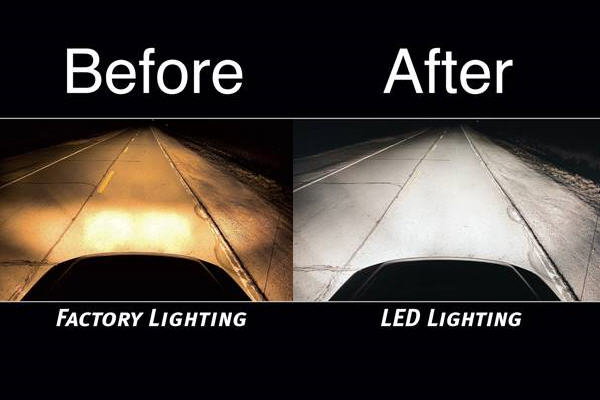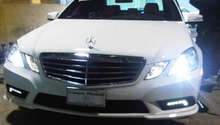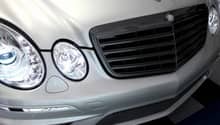Mercedes-Benz E-Class and E-Class AMG: Why are My Headlights Dim?
Are you having difficulty seeing at night due to dim headlights on your E-Class? Solve this issue yourself in a few simple steps with help from this article.
This article applies to the Mercedes-Benz E-Class and E-Class AMG (2002-2009).
Not all headlights on cars are the same, yet no matter what type of assembly, brand, or set-up you have in your car, the headlights will eventually need to be replaced. This isn't something that happens only to non-luxury vehicles with plastic headlight lenses. This article walks through a few of the issues that can affect your headlights as well as the options you can use to improve your driving field of view.

Step 1 – Adjusting the headlight beams
First, check the alignment of your headlight beams. Headlights can shift up or down over time from simply driving. They can lose alignment over time which will make them aim up or down, left or right. Visually, this could make your lights appear dim compared to what you are used to.
Pull up to your garage or a wall. Make sure the car is on as level of a location as possible.
- Open the hood with the lights on.
- There are three separate adjustment ports directly above the headlight assembly. One controls vertical movement for the high beam while one controls vertical movement for the low beam. The last one controls horizontal movement for each.

Pro Tip
Some cities and states have strict regulations on headlight beam adjustment. Make sure that you have checked with your local and state regulations for light settings. Improperly adjusted lights can blind someone for a short amount of time and possibly cause an accident.
Step 2 – Cleaning the inside of the lenses
Another issue many run into is fogging or dirt inside the housing. There will be a noticeable film on the lens. You have to use cleaner and some elbow grease to fix this. While the housings are supposed to be sealed, many have confirmed that they are not always tight. They can get that same or similar film on the inside of the lens housing. Once cleaned, they can become significantly clearer.
- You'll need to open the hood and go through the process of removing the light bulb as if you were planning on replacing it.
- The challenge is now finding or fabricating something that will allow you to reach the inside of the housing. The opening is very narrow and long. You'll need to be creative to do this. Fabricate something that can hold a soft towel or cotton ball. Put your favorite glass cleaning solution on the end and get in to the hard to reach places. You can use a metal wire or a thin stick for that.
- Once completed, you should see a sizable improvement.

Step 3 – Replacing the bulbs
Contrary to popular belief, all light bulbs do go bad, even factory HID bulbs. Of course, compared to halogen bulbs, HID bulbs last significantly longer. Most manufacturers will state that HID bulbs have a lifespan of roughly 2,000 hours, which of course is a long time, but they won't last forever. Generally speaking, replacing headlight bulbs is the fastest way to improve your field of vision.
- Replacing both light bulbs with the span manufacture run is recommended, meaning if one bulb goes out and the other does not, it is still advisable to replace both bulbs at the same time.
- There are kits that will allow you to move from a halogen set-up to Xenon gas or HID. Make sure your model can support an upgrade safely before proceeding with that installation.
- Follow the directions in the manual for proper headlight bulb replacement directions.
(Related Article: Mercedes-Benz E-Class and E-Class AMG: How to Replace Headlights with HIDs - MBWorld.org)

Pro Tip
Do your best to not touch the glass portion of any light bulbs. The grease on your fingers can accidentally cause damage to the light bulb when it gets extremely hot.
Related Discussions
- Dim Headlights - MBWorld.org
- Why are My Headlights Dim? - MBWorld.org






